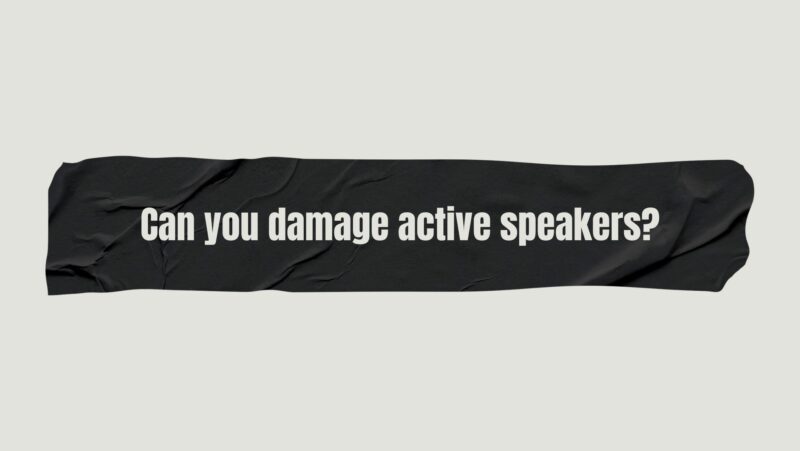Active speakers, also known as powered speakers, have gained popularity for their integrated amplification and convenient setup. These speakers offer an all-in-one solution that appeals to both audio enthusiasts and casual listeners. However, a persistent question lingers: can active speakers be damaged? As with any electronic device, concerns about potential damage are valid. In this comprehensive article, we delve into the intricacies of active speaker durability, explore common misconceptions, and provide insights into how users can ensure the optimal performance and longevity of their active speaker systems.
Understanding Active Speakers
Active speakers differ from passive speakers in that they incorporate built-in amplifiers, eliminating the need for an external amplifier. This design offers benefits such as simplified setup and improved compatibility with various audio sources. However, concerns about potential damage arise due to the presence of electronic components.
Component Durability and Misconceptions
- Quality Matters: Active speakers, like any audio equipment, vary in build quality and component integrity. High-quality active speakers built with durable materials and reliable components are less prone to damage.
- Misconception 1: Overpowering Speakers: One common misconception is that active speakers can be damaged by overpowering them. While pushing speakers beyond their limits can cause distortion and compromise audio quality, modern active speakers are often equipped with built-in protection mechanisms to prevent damage from excessive power.
- Misconception 2: Continuous Usage Causes Damage: It’s essential to differentiate between continuous usage and responsible usage. Active speakers are designed to handle regular usage, and the act of playing audio through them does not inherently cause damage.
Factors That Can Contribute to Damage
- Heat and Overheating: Excessive heat is a primary factor that can damage electronic components. Active speakers generate heat during operation, and inadequate ventilation or prolonged high-volume usage can lead to overheating and potential component failure.
- Improper Power Supply: Providing incorrect voltage or using an unreliable power source can cause electrical stress on internal components, leading to potential damage.
- Physical Impact: Like any piece of equipment, active speakers can be physically damaged through impacts, falls, or mishandling.
Common Issues and Prevention
- Component Degradation: Over time, components such as capacitors, resistors, and amplifier modules can degrade. Regular maintenance and avoiding extreme conditions can help prolong component life.
- Driver Damage: Speaker drivers, especially delicate tweeters, can be damaged if subjected to excessive volume levels or distorted audio signals.
Effective Practices to Prevent Damage
- Proper Ventilation: Ensuring that active speakers have adequate ventilation space prevents heat buildup and helps maintain internal component temperatures within safe limits.
- Volume Control: Avoid prolonged exposure to maximum volume levels, as this can lead to distortion and potential damage to drivers and amplifiers.
- Power Quality: Use a reliable power source with the correct voltage specifications to prevent electrical stress on components.
- Regular Maintenance: Periodically inspect active speakers for physical damage, clean the components, and address any signs of wear or degradation.
Manufacturer Guidelines and Recommendations
- User Manuals: Manufacturer guidelines and user manuals often provide essential information about recommended usage, maintenance, and precautions to prevent potential damage.
- Warranty Coverage: Active speakers typically come with warranty coverage that specifies conditions under which repairs or replacements are offered. Familiarizing oneself with the warranty terms can help in addressing potential issues.
Customizing Usage for Longevity
- Usage Patterns: Customizing usage patterns based on personal preferences and priorities can contribute to the longevity of active speakers. Avoiding excessive volume levels and providing breaks during extended usage can help.
- Quality Assurance: Investing in high-quality active speakers from reputable manufacturers enhances the likelihood of durability and reliable performance.
Conclusion
The question of whether active speakers can be damaged hinges on several factors, including build quality, proper usage, and maintenance practices. While some misconceptions suggest that active speakers are inherently fragile, responsible usage and adherence to manufacturer guidelines can mitigate potential damage. By understanding the technology, being aware of common issues, and taking proactive steps to prevent overheating, electrical stress, and physical damage, users can ensure the optimal performance and longevity of their active speaker systems. As with any valuable piece of audio equipment, responsible usage and care are paramount to enjoying the benefits of active speakers for years to come.


